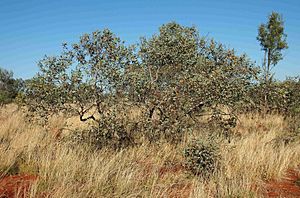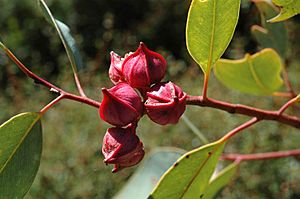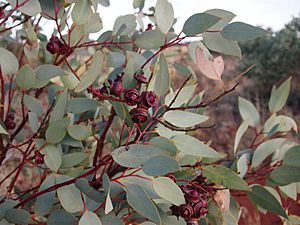Thick-leaved mallee facts for kids
Quick facts for kids Thick-leaved mallee |
|
|---|---|
 |
|
| Scientific classification | |
| Genus: |
Eucalyptus
|
| Species: |
pachyphylla
|
The Eucalyptus pachyphylla, often called the thick-leaved mallee or red-budded mallee, is a special type of mallee tree. It grows naturally in the dry, inland parts of Australia. This plant has smooth bark and leaves that look like eggs or spears. Its flower buds grow in groups of three and have five clear ribs. When the flowers turn into fruit, they are wide and shaped like a shallow cone or half a sphere.
Contents
What Does It Look Like?
The Eucalyptus pachyphylla is a mallee, which means it's a type of eucalyptus that grows many stems from a woody base. It usually grows to be about 1.5–5 m (4 ft 11 in – 16 ft 5 in) tall, but sometimes it can reach 7 m (23 ft). It has a special woody lump at its base called a lignotuber, which helps it regrow if it gets damaged.
The bark on this mallee is smooth. It can be white, grey, grey-brown, or even pinkish-grey or brown. It peels off in long, loose strips near the bottom of the tree.
Young plants and new shoots (called coppice regrowth) have rough, dull grey-green leaves. These leaves are shaped like eggs or spears and can be up to 160 mm (6.3 in) long and 50 mm (2.0 in) wide.
Adult leaves are thick and the same shade of green on both sides. They are also egg-shaped or spear-shaped, about 60–115 mm (2.4–4.5 in) long and 20–45 mm (0.79–1.77 in) wide. Each leaf has a stalk, called a petiole, that is 12–35 mm (0.47–1.38 in) long.
Flowers and Fruit
The flower buds grow where the leaves meet the stem (called the leaf axil). They appear in groups of three on a single stalk, known as a peduncle, which is 4–20 mm (0.16–0.79 in) long. Each individual bud has its own small stalk, or pedicel, about 3–10 mm (0.12–0.39 in) long.
When the buds are ready to open, they are oval-shaped, 18–32 mm (0.71–1.26 in) long and 13–25 mm (0.51–0.98 in) wide. They have five noticeable, thin ribs along their sides. The top of the bud, which is like a cap, is called an operculum and is shaped like a beak, measuring 13–25 mm (0.51–0.98 in) long. Close to flowering time, the buds turn a pretty pink color.
This mallee flowers between April and July. Its flowers are a creamy yellow color. After flowering, the plant produces a woody fruit. This fruit is a wide, shallow, cone-shaped or half-sphere-shaped capsule. It is 6–15 mm (0.24–0.59 in) long and 16–35 mm (0.63–1.38 in) wide, including its ribs. The parts that hold the seeds stick out above the edge of the fruit.
Its Scientific Name
The Eucalyptus pachyphylla was first officially described in 1859. A scientist named Ferdinand von Mueller wrote about it in a science journal called Journal of the Proceedings of the Linnean Society, Botany.
The second part of its scientific name, pachyphylla, comes from ancient Greek words. "Pachy" means "thick," and "phylla" means "leaved." So, the name literally means "thick-leaved," which describes its leaves very well! Sometimes, people mistakenly call another plant Eucalyptus pachyphylla when it's actually Eucalyptus alatissima.
Where Does It Grow?
You can often find the thick-leaved mallee growing on sand dunes and sandy flat areas. It also likes rocky slopes. It grows best in red sandy soils.
In Western Australia, it is found in many parts of the Pilbara and Goldfields-Esperance regions. You can also find this plant in the Northern Territory, South Australia, and Queensland.
Why People Plant It
This mallee is sold in plant nurseries. People like to use it as a decorative plant in their gardens. It can also be planted to create a natural screen or a windbreak, which helps block wind. Birds are often attracted to its flowers, making it a good choice for bird lovers.
For it to grow well, it needs to be planted in a spot where it gets full sun. It can handle dry periods (drought) and can also survive moderate frosts.




